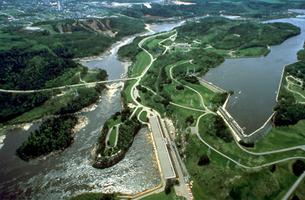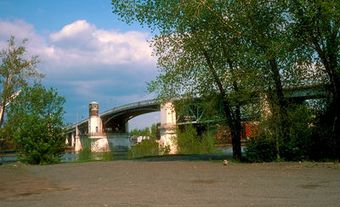Chicoutimi
Chicoutimi, Québec, city, pop 60 008 (2001c), 63 061 (1996c), 62 670 (1991c), pop 61 083 (1986c), area 156.11 km2, inc 1976, is located at the confluence of the Chicoutimi and Saguenay rivers between Jonquière and La Baie, 211 km north of Québec City. In the Montagnais language, Chicoutimi means "the end of the deep waters" - a reference to the tides reaching that point.
Settlement
Chicoutimi was an important staging point on the route that 17th-century Indigenous hunters took to sell their furs in Tadoussac, and in 1676 New France authorities built a trading post here. Peter McLeod, Jr, founder of the present city, built sawmills on the du Moulin and Chicoutimi rivers (1842-43), which were acquired by William Price in 1852 and operated until the early 20th century.
Development
The town's wholesale and retail trade expanded because of its role as a maritime (1875) and railway (1893) terminal. In 1898 the Compagnie de pulpe de Chicoutimi opened its first pulp mill here, which grew rapidly until the paper industry crisis of the 1920s, and the economic collapse of 1929 forced its closure. Prosperity returned with WWII, when many unemployed found work in the Arvida (now Jonquière) aluminum works. The service sector experienced rapid growth, making Chicoutimi a tertiary centre. Regional capital of Saguenay-Lac-St-Jean, county seat of Chicoutimi and headquarters of the judicial district of the same name, the city has been a diocesan centre since 1878 and has a major hospital (1884) and a university (Université du Québec à Chicoutimi, 1969).
Cityscape
The present city is the amalgamation of the municipalities of Chicoutimi, Chicoutimi-Nord, Rivière-du-Moulin and the parish of Chicoutimi. Chicoutimi-Nord lies to the north of Chicoutimi across Rivière du Moulin in the east and Rivière Chicoutimi in the west flows through the former municipalities of the same names. In July 1996 the city experienced severe flooding from the latter 2 rivers. Chicoutimi was not alone, for flooding occurred throughout the Saguenay-Lac-Saint-Jean region in what is considered the most severe flooding in Canadian history.
Cultural Life
While developing its future, the city remains attached to its past. It houses the Société historique du Saguenay (1934), one of the major private historical societies of North America, and the Musée du Saguenay-Lac-St-Jean (1959). As well, the Corporation de la vieille pulperie has restored the remains of the wood-pulp factories, a significant item in Canada's industrial heritage.
Each February Chicoutimi hosts the Carnaval-Souvenir, which recalls the ancestral days of over 100 years ago. Finally, the city is the departure point for cruises through the majestic fjord of the Saguenay.

 Share on Facebook
Share on Facebook Share on X
Share on X Share by Email
Share by Email Share on Google Classroom
Share on Google Classroom






